Market
The Evolution of the Governance Model
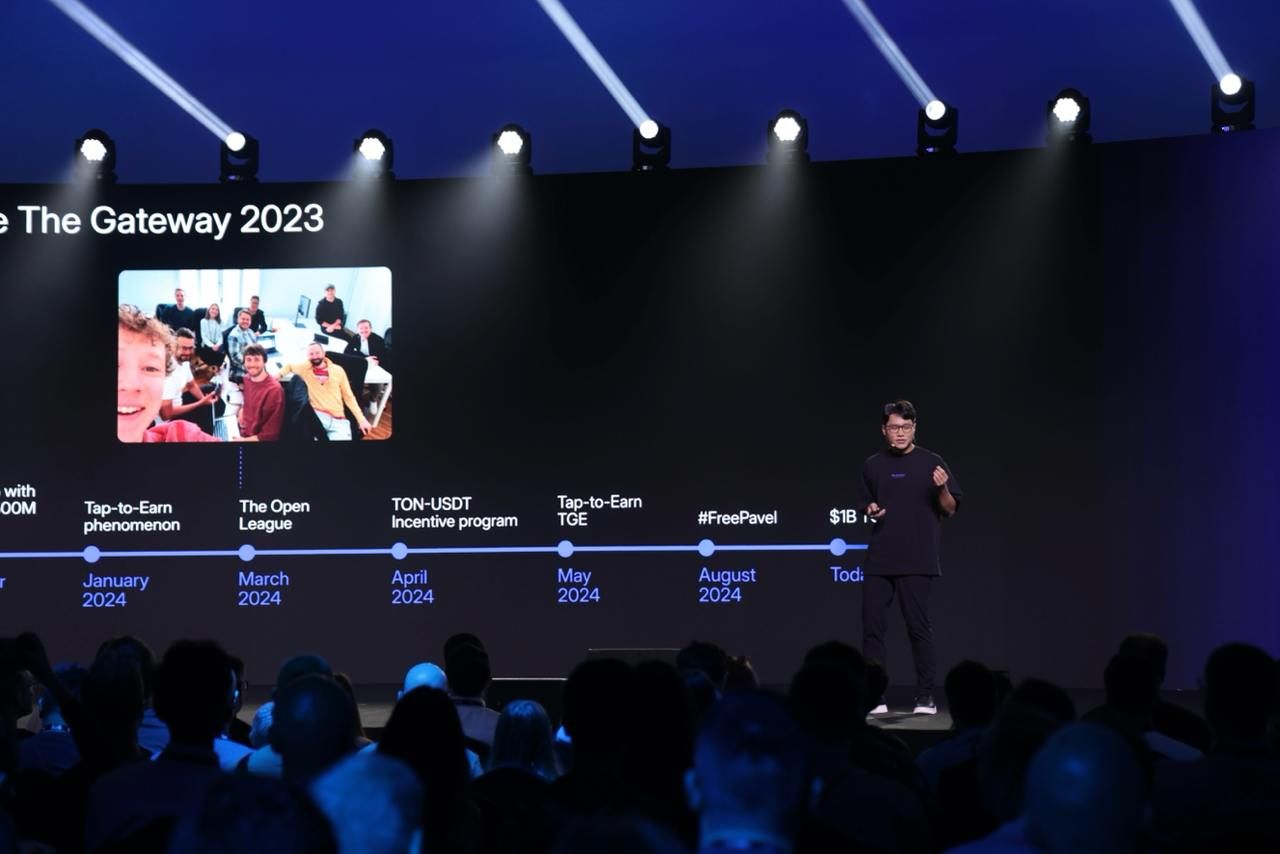
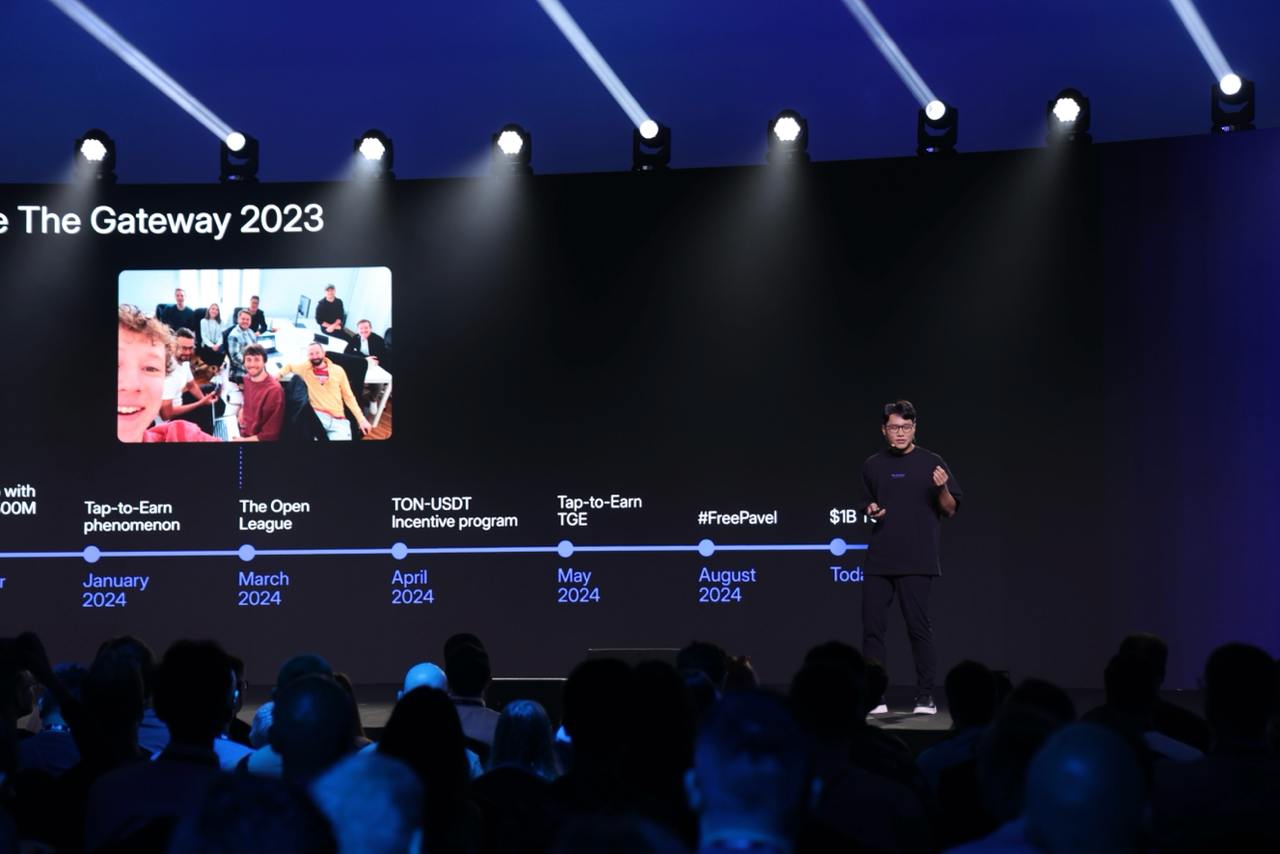
Co-AuthoredbySteveYun,President-TheOpenNetworkFoundation&JackBooth, Co-Founder – TON Society
The TON community has matured impressively in the past year. TON keeps connecting the crypto industry to a mass audience of new users, while successful projects constantly emerge. Advocating for decentralization and reactive to community growth and maturity, The Open Network Foundation (“Foundation”) introduces Society DAO, a new governance model.
TON has been community-driven from day one. From its inception, the network has thrived thanks to dedicated community validators, securing its integrity, and resilience. The platform’s growth has been led by developers who won public contests, becoming the leading contributors committed to TON’s vision. TON’s launch was uniquely fair, with initial distribution powered by Proof-of-Work mining, allowing participants to earn a stake. As the ecosystem expanded, the TON Foundation took the helm in business development, fueling a robust and dynamic ecosystem loyal to its decentralized, community-first ethos.
Honoring this DNA, The Open Network Foundation (“Foundation”) introduces Society DAO, a new governance model. We envision a governance framework that enhances decentralization, transparency, inclusion, competition, autonomy, participation, and resilience by democratizing access to the financial, socio-political, and human capital.
Decentralization is an ongoing process. Over the past year, many founders have relied heavily on the Foundation for success, as it often serves as a central hub for capital. However, the Foundation sees this as a centralization risk—one that could lead to a single point of failure.
How can the Foundation evolve to mitigate this risk and empower a more resilient, decentralized ecosystem?
L1 governance faces complex challenges, starting with a concentration of capital. Across the blockchain industry, platforms often adopt a corporate model, with foundations overseeing strategy, partnerships, marketing, technical support, funding, and more. This centralized model can be efficient in the early stages, providing direction and producing initial use cases.
However, as the ecosystem matures and independent, competitive participants emerge, this model reveals its limitations. Capital and resources—financial, social, human, and political— accumulate around the foundation, making it difficult for projects to succeed without its official
support. This concentration creates a gated environment, stifling the competition that’s crucial for a thriving ecosystem.
Additionally, operational inefficiencies arise as projects focus on navigating foundation processes instead of building products, leading to a lack of competitive innovation. Over time, this dependency risks undermining the original goal of ecosystem building, which requires decentralized, open support for incoming builders.
To address the challenges of centralized governance the answer lies in democratized access to capital and fostering competition within a community-centric framework. By implementing
open-source access to capital, projects earn resources transparently, rewarded for achieving key performance indicators (KPIs), which shift their focus to delivering exceptional products and results. In line with this, the Foundation is advancing a Community Model that redistributes resource allocation power back to the community. Under this approach, respected and proven community members are empowered to coordinate vision, goals, and strategies, collectively determining resource allocation in alignment with TON’s overall growth.
This model also upholds a principle of competition, supporting at least two projects in each category, encouraging projects to excel, and fueling a vibrant innovative ecosystem. Previously monopolized roles within the Foundation can now be filled by competitive, independent teams, enhancing efficiency and resilience. Thanks to TON’s explosive growth and the emergence of widely respected ecosystem leaders, the Community Model enables proactive, autonomous, and competitive participation in the network.
Since its inception in 2023 as a Swiss non-profit, the Foundation has tested this model with a few leading teams, who have excelled in their roles. This competitive and decentralized model accelerates growth, promotes autonomy, and empowers community-led development, providing a scalable framework and better results for all TON ecosystem participants.
With blockchain technology, the technical path to decentralization is clear. However, building a community capable of collective, coordinated action requires a more strategic approach. As the TON ecosystem grows, decentralizing at its core is essential to ensure resilience and long-term success.
Today, The Foundation is pleased to introduce Society DAO and its founding members; teams that have already been operating independently yet aligned with TON’s mission. Society DAO will become the organizing body for core ecosystem functions, its founding members comprise:
- TONCore:Core development, upgrading, and maintenance of the blockchain
- TONStudio:Developer experience
- TONSociety:Community operations
- WalletinTelegram:Payment adoption
The Foundation will support this DAO by reporting on its goals, KPIs, and strategies, ensuring compliance, and providing grants and other resources. Society DAO will grow to include proven and reputable community teams that can propose and execute a plan that supports the ecosystem’s objectives. It will welcome new contributors across roles such as marketing, app development, technology, stablecoin integration, DeFi, community growth, identity, and more.
This model will make the community’s brightest minds the key stakeholders in the growth and adoption of TON.
The TON ecosystem is committed to a transparent path for accomplishing its goals. Like our network’s dynamic sharding architecture, smaller, independent, and focused teams can create better, more scalable outcomes. Our public goals are revisited every six months, ensuring they remain relevant and aligned with our community’s vision.
- TONEcosystemGoals: Society DAO will publish The TON Ecosystem goals
- CommunityProposals: DAO members can propose relevant strategies, expected time-bound, and specific key results for achieving the ecosystem goals.
- WorkingGroupReviews: Relevant DAO members will evaluate proposals across specialized working groups.
- GrantProvided: After DAO approval, The Foundation funds the plans, with the community team assuming responsibility for progress and performance.
Today, Society DAO sets the following initial goals:
- PositionTONasTheGatewaytoReal-WorldCryptocurrencyUseCases.
- EstablishTONastheMostStableandScalableBlockchain.
- GrowtheDeveloperandUserCommunityinSuperAppmarkets.
By January 2025, Society DAO will publicly publish the key initiatives and expected key results for H1 2025. With a public view over Society DAO’s objectives, the community can contribute their opinions and help guide the DAO on how best to achieve the Ecosystem goals. Shortly, Society DAO will continue to decentralize by inviting proposals from proven and reputable community teams. Successful proposals that align with our ecosystem goals can join the DAO as members, becoming core contributors to The Open Network.
In 2025, Society DAO will enhance its transparency and community-driven focus by launching a public debate and voting platform. This platform will use TON Society onchain badges as a reputation marker, empowering active community members to have a voice in decision-making processes.
Over 3.6 million users have earned onchain badges on society.ton.org. This activity-driven reputation reflects your contribution and engagement within the ecosystem and will open access to contributing to debates and onchain votes.
Once the platform is live, DAO members will be supported by the real opinions of the active community. Together, we will cultivate an ecosystem of DAO members that self-regulates autonomously by collective insight and engagement.
To ensure a decentralized approach, Society DAO is establishing the Principle of Competition as a core guideline for allocating all public resources, including financial, social, human, political capital, and incentive programs. This principle requires that at least two competing projects be provided with the opportunity to fulfill the KPIs in the same category.
Competition creates decentralization. Competitive environments make it difficult for single players to dominate. When an ecosystem depends on multiple players, it becomes more resilient to failures. If one competitor encounters issues or fails, others can take their place without significant disruption. Competitive ecosystems lead to higher transparency, as entities are motivated to act in users’ best interests to maintain loyalty.
Moreover, competition encourages different approaches and ideas to address user needs. Each competitor brings unique strengths or innovations, leading to a richer ecosystem where multiple solutions coexist, reducing reliance on any single provider. Ultimately, this leads to a better user experience.
Society DAO positions the TON community on the right trajectory to become more competitive, decentralized, and resilient. Overall, it aims to create a robust and scalable organizational structure. As this model continues to be proven further, it will lead to an autonomous community capable of collective action.
With a growing community of over 20 million members, we are stronger than ever and have the potential to make cryptocurrency accessible to everyone. Together, we can drive meaningful change and put crypto in every pocket.
Disclaimer
In compliance with the Trust Project guidelines, this guest expert article presents the author’s perspective and may not necessarily reflect the views of BeInCrypto. BeInCrypto remains committed to transparent reporting and upholding the highest standards of journalism. Readers are advised to verify information independently and consult with a professional before making decisions based on this content. Please note that our Terms and Conditions, Privacy Policy, and Disclaimers have been updated.
Market
Top 3 Made in USA Coins to Watch In April

Made in USA coins continue to try a rebound, with Solana (SOL), RENDER, and Jupiter (JUP) standing out as key names to watch in April. Despite recent price corrections, each of these tokens plays a major role in high-growth areas like DeFi, AI, and blockchain infrastructure.
Solana has seen its price dip, but ecosystem activity remains strong; RENDER is riding the wave of AI demand despite market turbulence; and Jupiter is showing solid usage metrics even as its token struggles. Here’s a closer look at the technical and fundamental setups for each of these standout U.S.-based projects.
Solana (SOL)
Solana has faced a notable price correction over the past week, with its value dropping nearly 13%. If this bearish momentum continues, the token could be on track to retest the critical support level at $120.
A breakdown below that could see SOL sliding further toward the $112 mark.
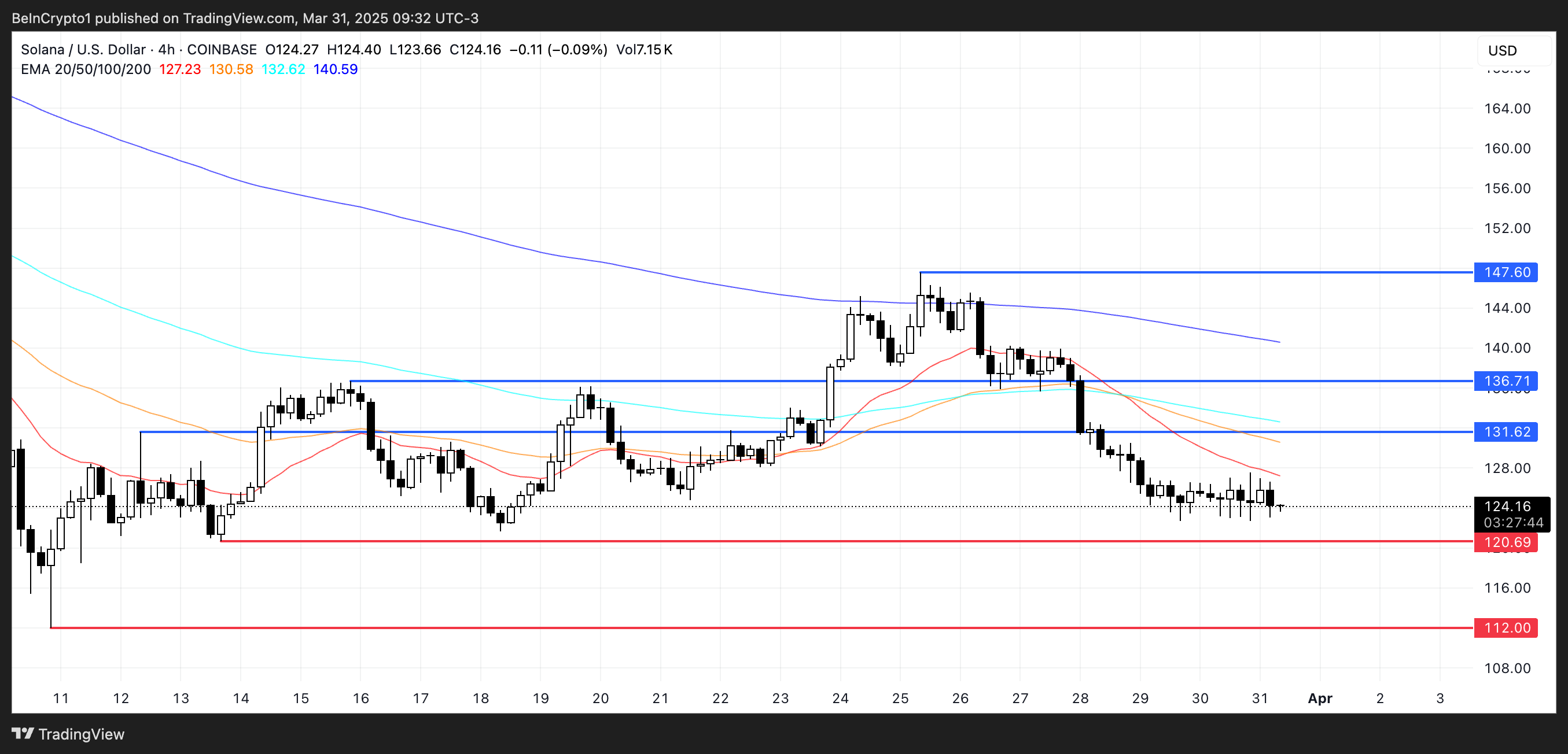
Despite the recent downturn, Solana remains one of the most relevant Made in USA coins and continues to show impressive usage metrics. PumpFun, for example, generated nearly $9 million in revenue over the past 24 hours, second only to Tether.
After a short period when BNB led the DEX volume race, Solana seems to be regaining traction—its decentralized exchange volume has surged by 128% in just seven days, reaching $18 billion and surpassing both Ethereum and BNB.
If this recovery in momentum persists, SOL could target a move toward the $131 resistance level. A successful breakout there could open the door to further gains toward $136 and potentially $147.
RENDER
RENDER, one of the most prominent U.S.-based cryptocurrencies with a focus on artificial intelligence, has seen its price decline nearly 11% over the past seven days.
This drop reflects the broader correction that has impacted many AI-related tokens in recent months.
However, new developments in the AI infrastructure space may provide a catalyst for a potential rebound, especially as the limitations of centralized systems become clear.
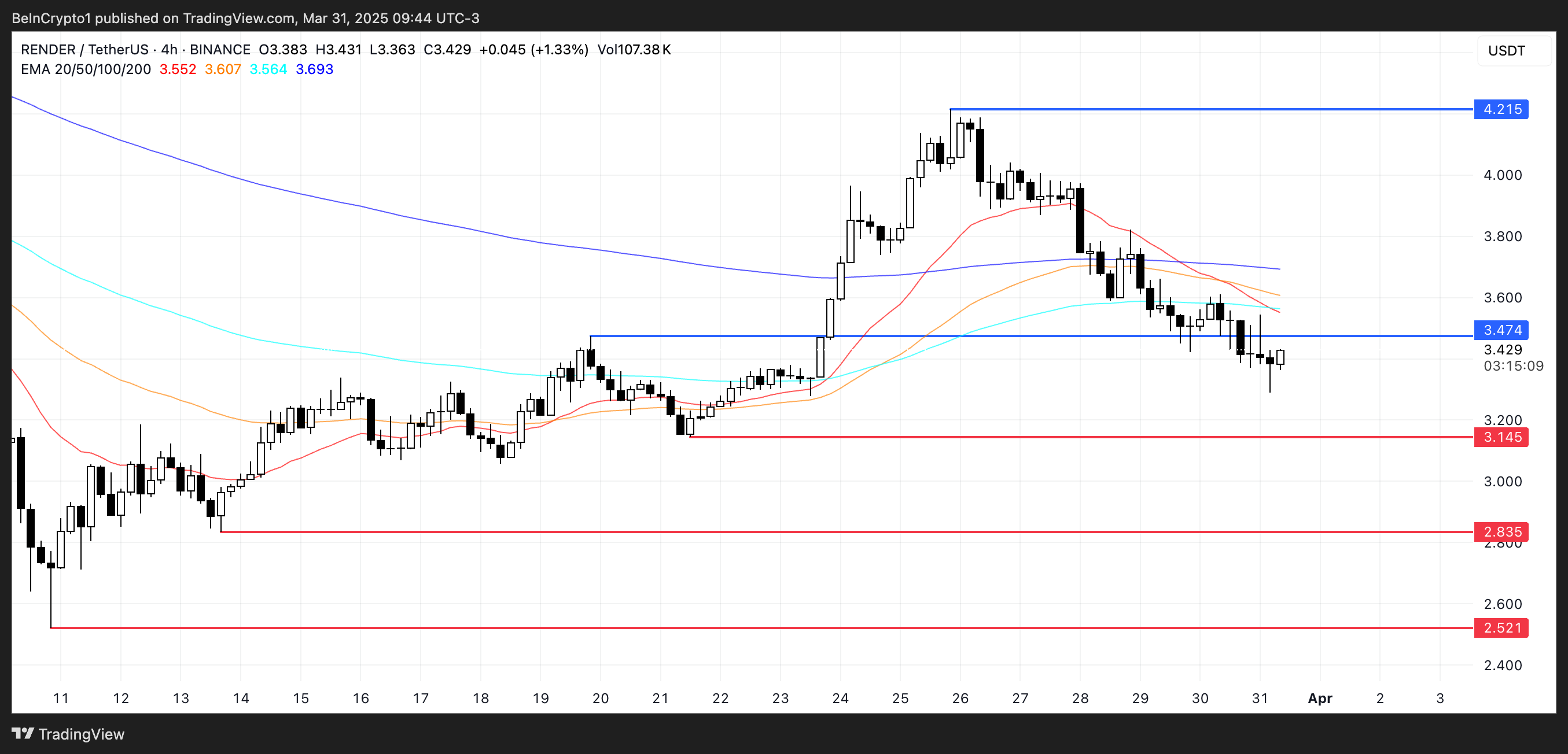
If bullish momentum returns to the AI sector, RENDER could look to challenge the resistance at $3.47, and a successful breakout might open the door for a rally toward $4.21.
However, if the current correction deepens, the token could fall to test the $3.14 support level. A breakdown there may trigger further losses, potentially dragging RENDER down to $2.83 or even $2.52—its lowest level in recent weeks.
Jupiter (JUP)
Despite Solana’s recent struggles, Jupiter—its leading DEX aggregator—is demonstrating impressive strength in terms of activity.
In the last 24 hours, Jupiter ranked as the fourth-highest protocol in crypto by fee generation, collecting nearly $2.5 million.
Only Tether, PumpFun, and Circle managed to outperform it, highlighting the platform’s growing relevance within the Solana ecosystem even during periods of broader market weakness.
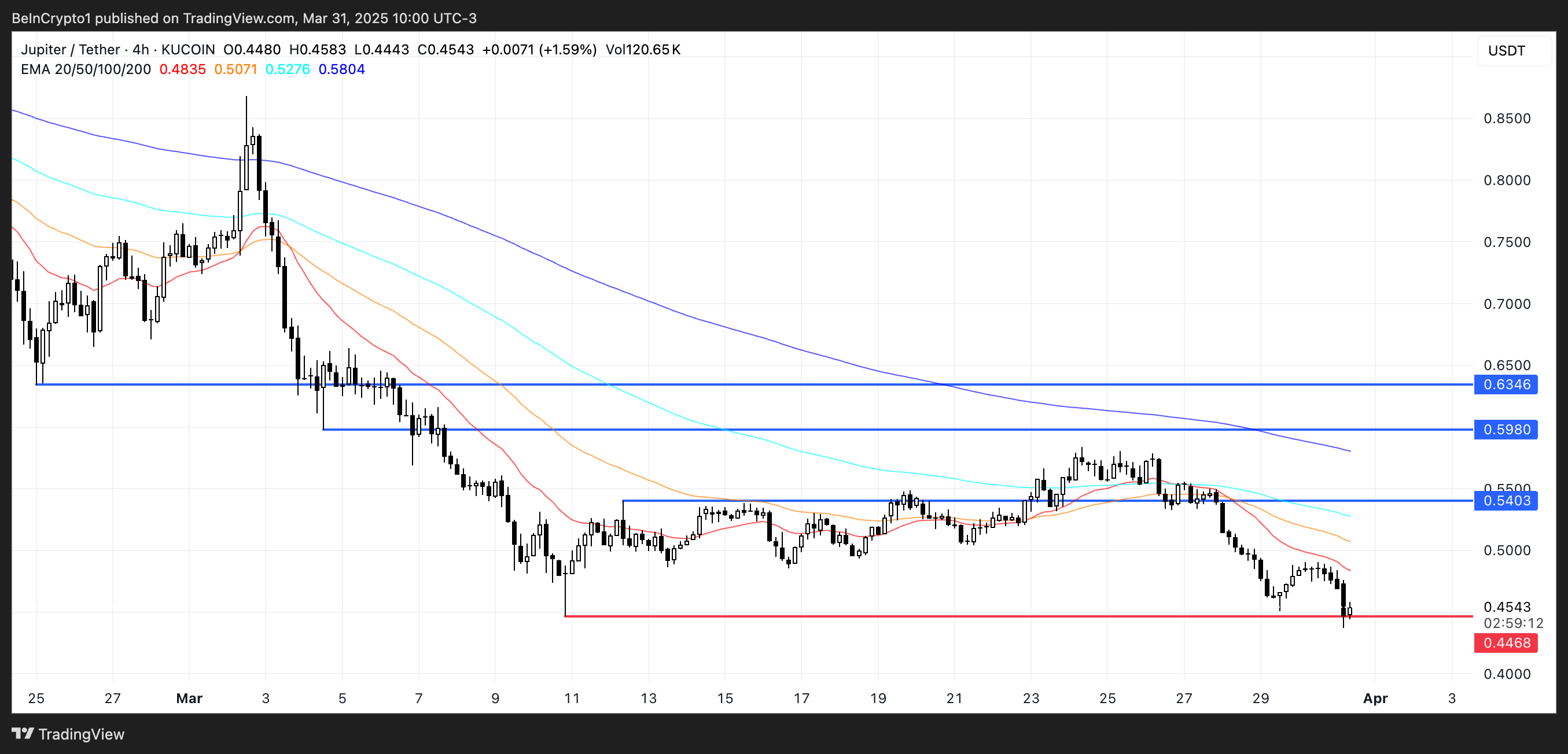
However, JUP, Jupiter’s native token, hasn’t mirrored this positive momentum. Its price has dropped over 21% in the past week, being one of the worst performers among the biggest Made in USA coins. It has remained below the $0.65 mark for three consecutive weeks.
With JUP now hovering dangerously close to a key support at $0.44, a breakdown could see the token dip below $0.40 for the first time ever.
Still, if market sentiment shifts and momentum returns, JUP could begin climbing again—first testing resistance at $0.54, then potentially moving toward $0.598 and even $0.63 if bullish pressure intensifies.
Disclaimer
In line with the Trust Project guidelines, this price analysis article is for informational purposes only and should not be considered financial or investment advice. BeInCrypto is committed to accurate, unbiased reporting, but market conditions are subject to change without notice. Always conduct your own research and consult with a professional before making any financial decisions. Please note that our Terms and Conditions, Privacy Policy, and Disclaimers have been updated.
Market
Cardano (ADA) Whales Hit 2-Year Low as Key Support Retested

Cardano (ADA) is facing mounting pressure as its price corrects by 10% over the past seven days, continuing a broader downtrend that has kept it trading below the $1 mark for nearly a month. With technical indicators flashing warning signs and large holders exiting their positions, concerns around ADA’s short-term stability are growing.
The recent rejection at higher resistance levels and a strong directional trend signal suggest that bearish momentum is far from over. As the $0.64 support level is tested once again, ADA’s next move could determine whether a rebound is possible—or if further downside is ahead.
Cardano ADX Shows The Downtrend Is Very Strong
Cardano’s Average Directional Index (ADX) is currently at 40.19, rising sharply from 15.83 just four days ago. This steep increase suggests a rapid strengthening in the trend’s momentum.
Given that ADA is currently in a downtrend, the rising ADX indicates that bearish momentum is intensifying and the current downward move is gaining traction.

The ADX is a trend strength indicator that measures how strong a trend is, regardless of its direction. It ranges from 0 to 100, with readings below 20 typically indicating a weak or non-existent trend, while values above 25 suggest a strong trend is in place.
Cardano’s ADX climbing above 40 confirms that the current downtrend is active and becoming stronger. If this trend continues, it may point to further downside pressure unless a shift in momentum begins to build from the bulls.
ADA Whales Dropped To Their Lowest Level Since February 2023
The number of Cardano whales—wallets holding between 1 million and 10 million ADA—has dropped to 2,406, down from 2,421 just four days ago.
This decline brings the whale count to its lowest level since February 2023, marking a potentially meaningful shift in large-holder behavior. These movements are worth paying attention to, as changes in whale holdings often precede broader market trends.
Tracking whales is important because these large holders can significantly influence price action through their buying or selling decisions. A decline in whale numbers can signal reduced confidence or capital rotation into other assets.
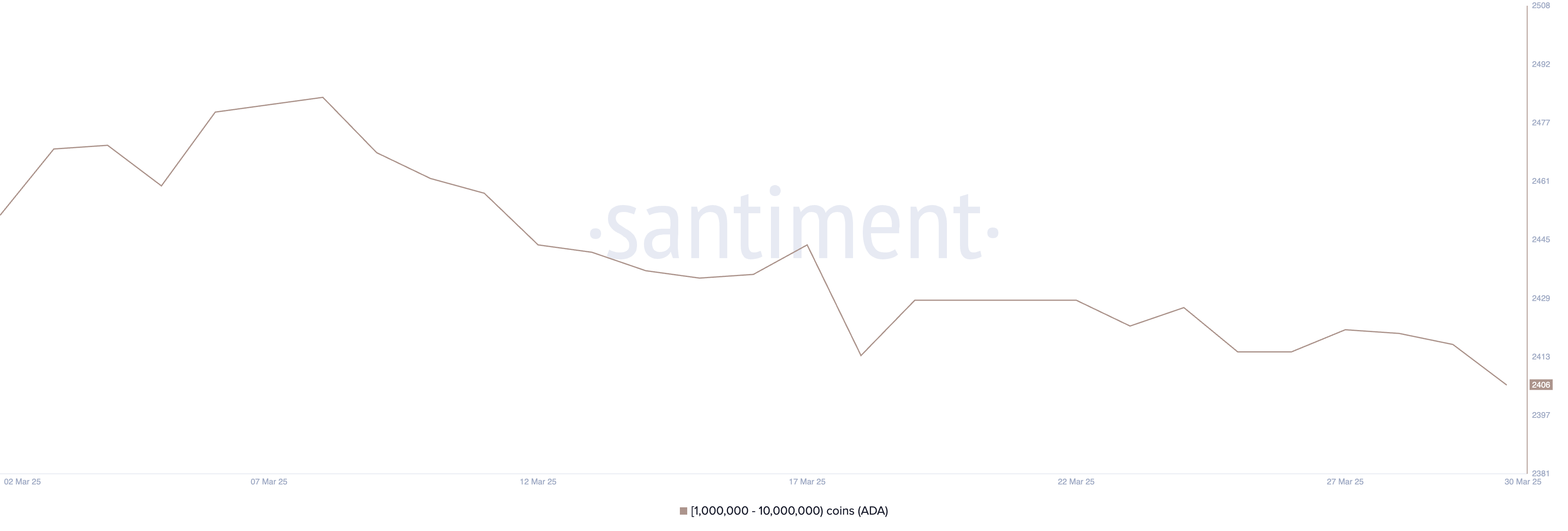
In Cardano’s case, the drop suggests that some major players may be exiting or reducing exposure, which could add downward pressure to ADA’s price.
If this trend continues, it could weaken investor sentiment and make it harder for ADA to recover in the short term.
Can Cardano Sustain The $0.64 Support Again?
Cardano price recently tested the support level at $0.64 and managed to hold, showing that buyers are still defending that zone. This support has become a key line in the sand for ADA’s short-term outlook.
If the current downtrend is reversed and bullish momentum picks up, the next upside target would be the resistance at $0.69. A breakout above that level could open the door for a push toward $0.77.
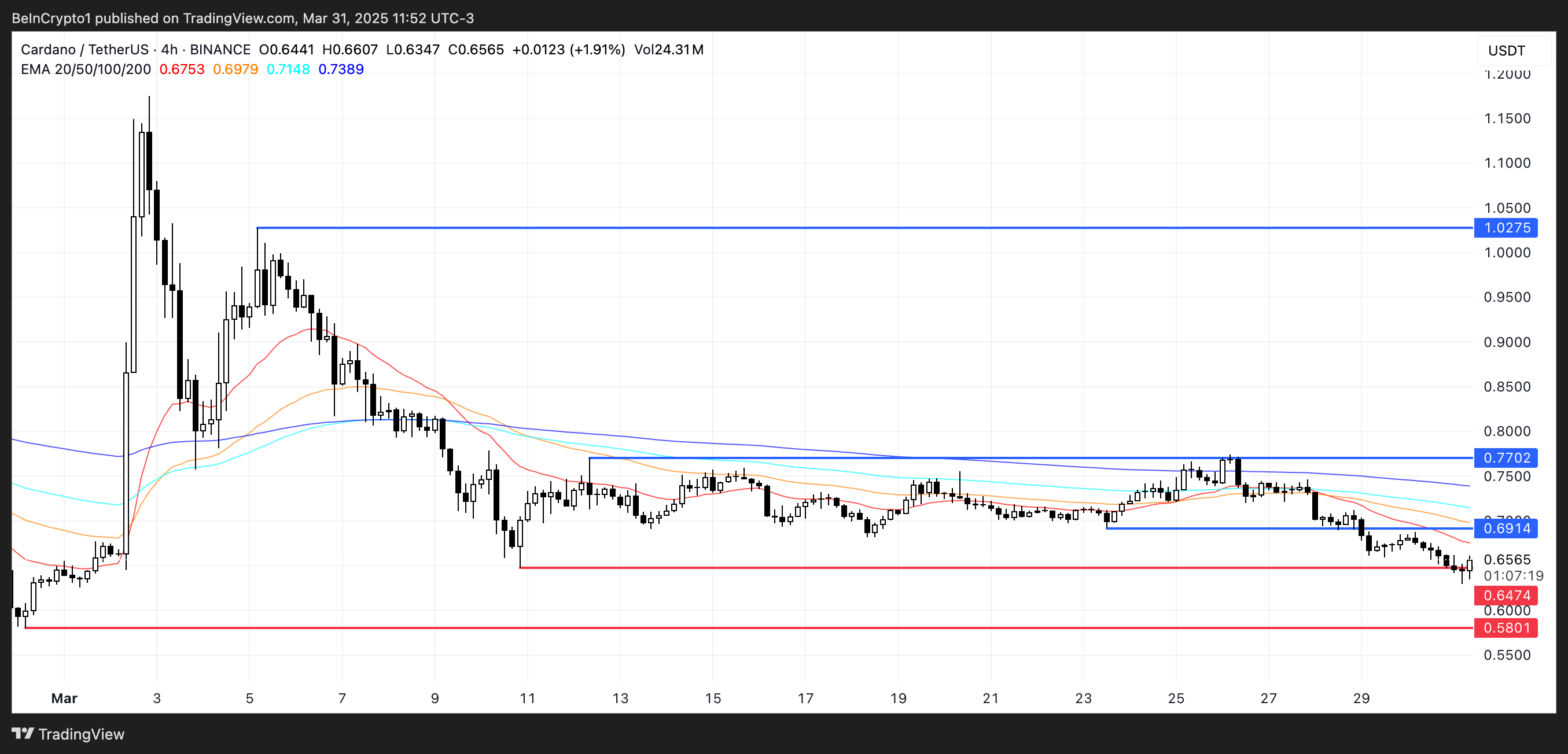
Should the rally continue with strength, ADA could aim for $1.02—marking a return above the $1 level for the first time since early March.
However, the $0.64 support remains a critical level to watch. If Cardano tests it again and fails to hold, it could indicate weakening buyer conviction.
A breakdown below $0.64 would likely send ADA toward the next support at $0.58. This would confirm a continuation of the downtrend and possibly trigger further selling pressure.
Disclaimer
In line with the Trust Project guidelines, this price analysis article is for informational purposes only and should not be considered financial or investment advice. BeInCrypto is committed to accurate, unbiased reporting, but market conditions are subject to change without notice. Always conduct your own research and consult with a professional before making any financial decisions. Please note that our Terms and Conditions, Privacy Policy, and Disclaimers have been updated.
Market
This is Why PumpSwap Brings Pump.fun To the Next Level

Since launching PumpSwap, token launchpad Pump.fun has resumed its position as a top-level protocol by fees and revenue. It saw over $2.62 billion in volume in less than two weeks, signifying high market interest.
Nonetheless, the meme coin sector as a whole has been more volatile than usual lately. PumpSwap is an attractive new option, but it still needs to stand the test of time.
Pump.fun Surges with PumpSwap
Pump.fun, a prominent meme coin creation platform, recently suffered some difficulties in the market. Facing lawsuits and criticism from the industry, the platform’s revenue had been declining in 2025. However, since launching PumpSwap, Pump.fun’s income has rebounded, making it one of the largest protocols by fees and revenue.

PumpSwap is a decentralized exchange on Solana’s blockchain, and it has grown very quickly since its launch less than two weeks ago. It has already managed over $2.62 billion in trade volume, although its daily volume fell over the weekend. Pump.fun’s cofounder spoke highly about PumpSwap, calling it a “crucial step that will help grow the ecosystem.”
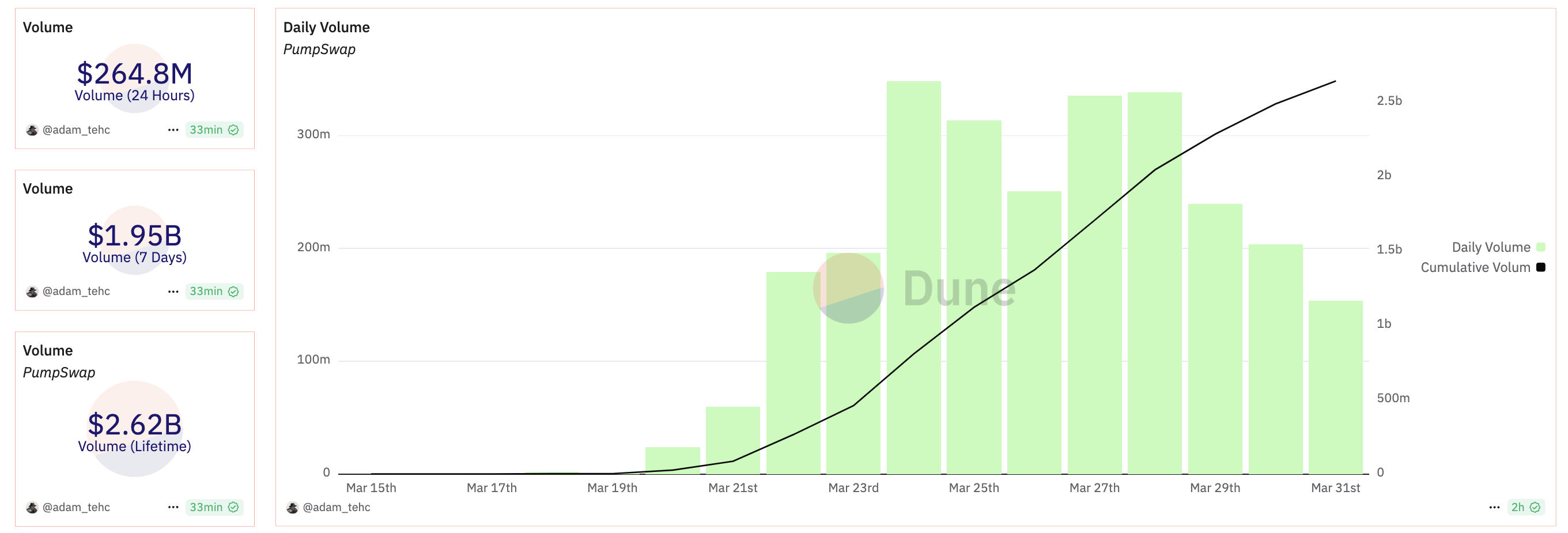
Pump.fun’s overall revenues were declining before it launched PumpSwap, and they have since jumped back up. However, it’s important to not overstate the new exchange’s success. The exchange’s total fees collected have skyrocketed compared to Pump.fun, but the actual revenue growth has been comparatively small.
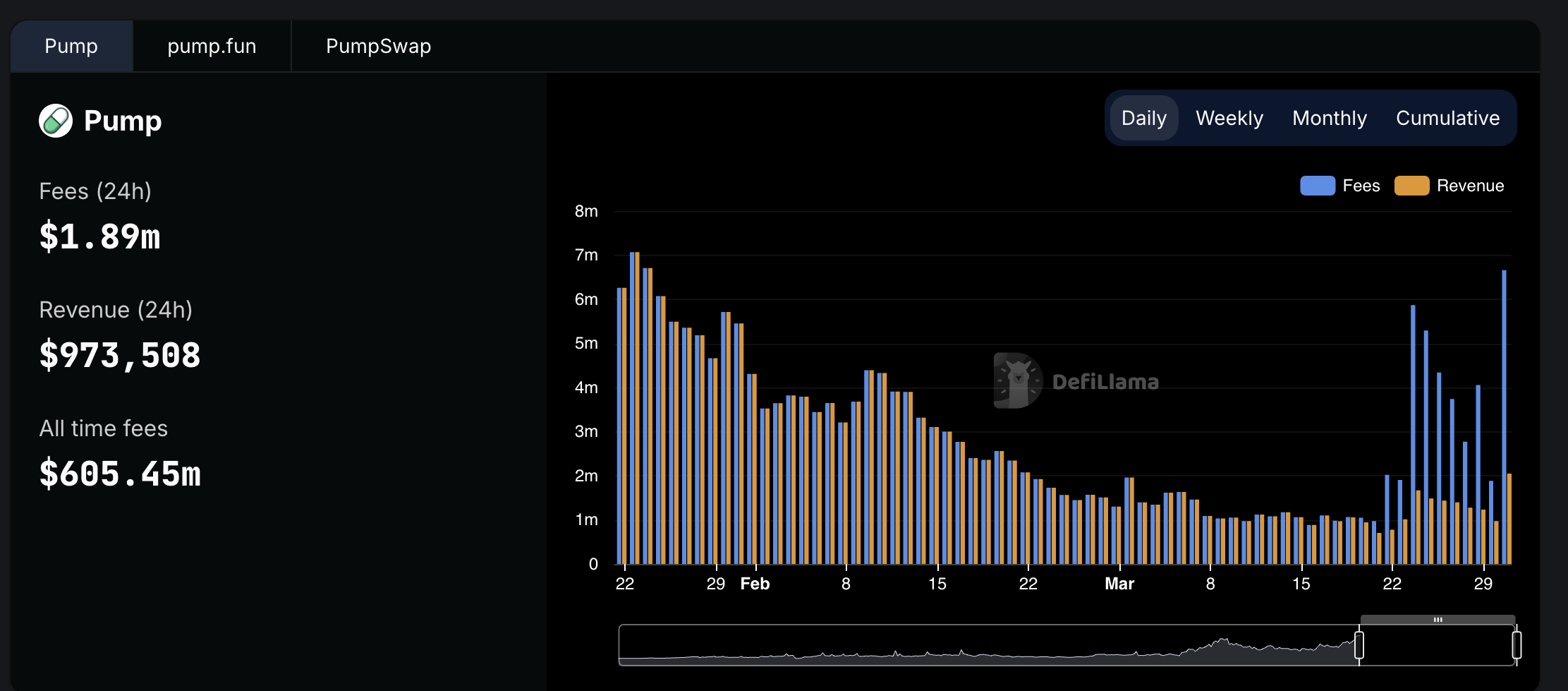
Still, these low fees also have significant advantages. Demand seems to be drying up in the meme coin sector, but Pump.fun faces stiff competition in the form of firms like Raydium, using low fees as a competitive edge. It has also promised things like revenue sharing with token creators to promote ecosystem growth.
Ultimately, the meme coin market as a whole is full of uncertainty. PumpSwap has been able to keep Pump.fun competitive as a top-level platform in this space, giving it a welcome reprieve. The real challenge will come in determining long-term viability.
Disclaimer
In adherence to the Trust Project guidelines, BeInCrypto is committed to unbiased, transparent reporting. This news article aims to provide accurate, timely information. However, readers are advised to verify facts independently and consult with a professional before making any decisions based on this content. Please note that our Terms and Conditions, Privacy Policy, and Disclaimers have been updated.
-

 Market21 hours ago
Market21 hours agoEthereum Price Weakens—Can Bulls Prevent a Major Breakdown?
-

 Market22 hours ago
Market22 hours agoBitcoin Bears Tighten Grip—Where’s the Next Support?
-
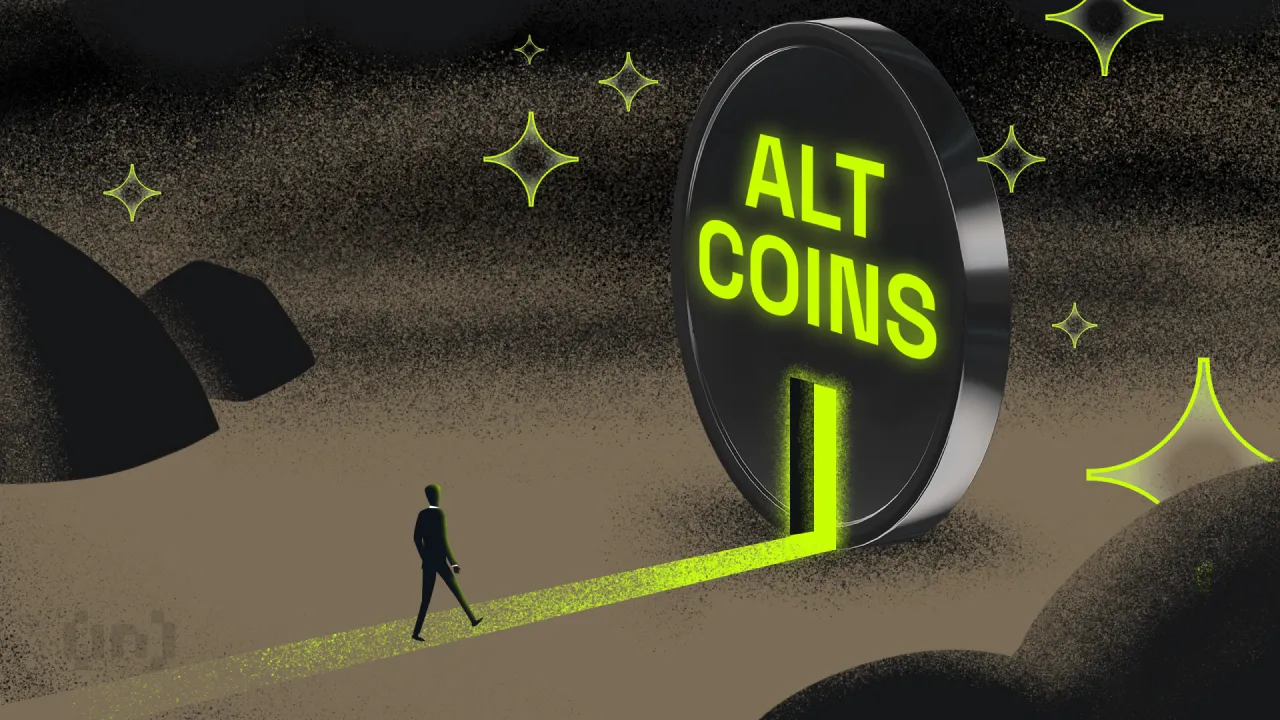
 Altcoin13 hours ago
Altcoin13 hours ago$33 Million Inflows Signal Market Bounce
-

 Market20 hours ago
Market20 hours agoXRP Price Fate Hangs on $2.00—Major Move Incoming?
-

 Ethereum13 hours ago
Ethereum13 hours agoEthereum To $20K? Investor Says Real-World Adoption Is The Key
-

 Market19 hours ago
Market19 hours agoDogecoin (DOGE) Bulls In Trouble—Can They Prevent a Drop Below $0.15?
-
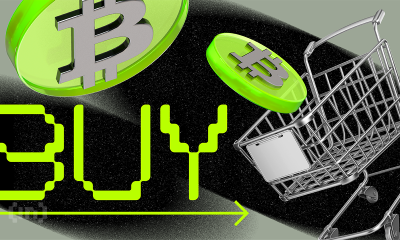
 Bitcoin13 hours ago
Bitcoin13 hours agoBTC Price Rebound Likely as Long-Term Holders Reenter Market
-

 Market18 hours ago
Market18 hours agoBitcoin Price Nears $80,000; Fuels Death Cross Potential





















